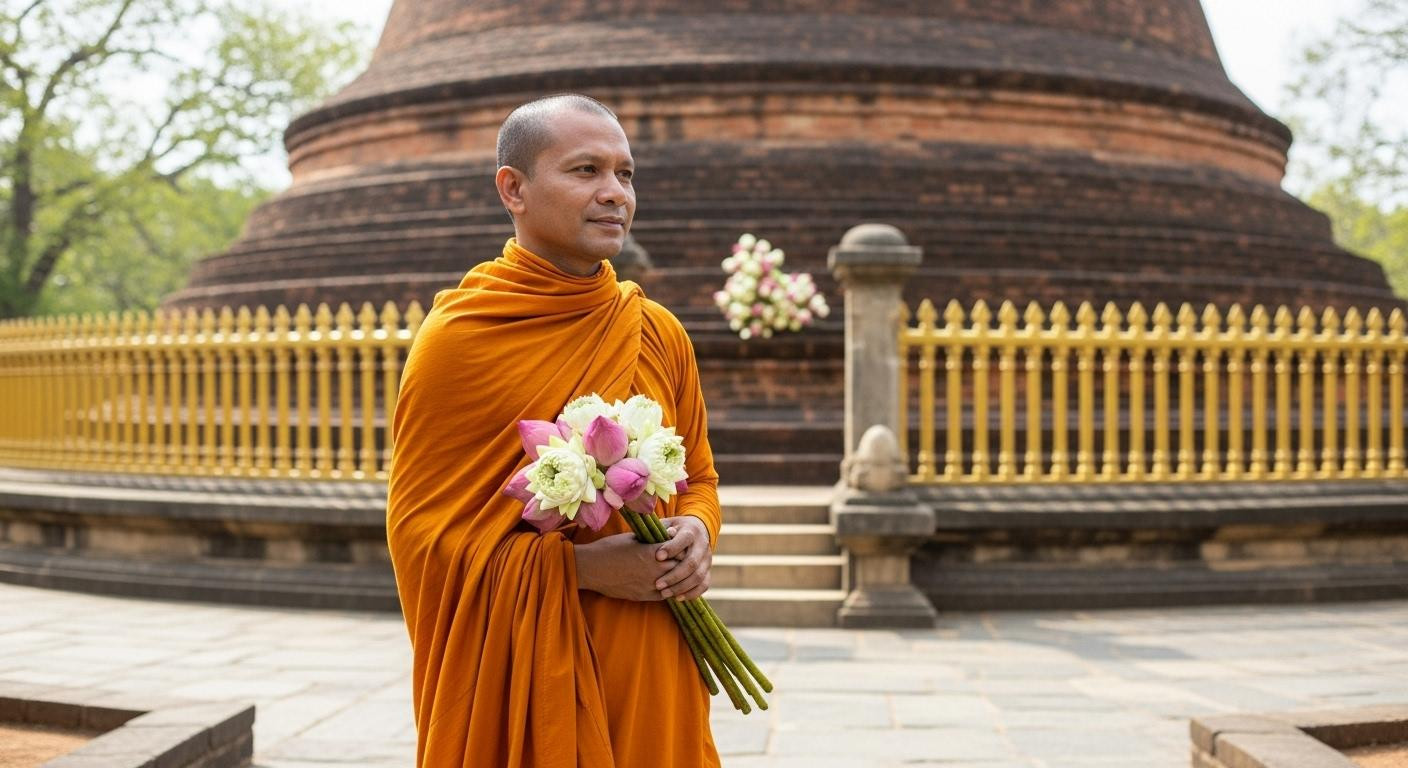The temple drum echoes across 16 square miles of ancient brick at 4:30 AM. You’re removing shoes at the Ruwanwelisaya Stupa while monks in saffron robes prepare morning chant. Three days ago, UNESCO sites meant selfie spots and guidebook boxes to check. Now, standing barefoot on stone warmed by 2,300 years of pilgrims, breathing incense and lotus flowers, something fundamental shifts. This isn’t tourism. This is participation in living Buddhist time.
Where 50,000 residents cycle past 1,300 years every morning
Steam rises from tea stalls as dawn breaks over Anuradhapura. Monks walk past Jetavanaramaya’s 400-foot brick tower, carrying alms bowls older than European cathedrals. Locals cycle to market along paths beside ancient monasteries, their daily rhythm unchanged for centuries.
This isn’t Angkor Wat’s frozen archaeology or Machu Picchu’s roped-off ruins. Here, temple bells wake the living city at dawn, just as they have since the 4th century BCE. The Sri Maha Bodhi Tree receives lotus offerings at sunrise while children play cricket near stupas that rival Egypt’s pyramids in scale.
November brings relief from Sri Lanka’s heat. Morning temperatures hover at 75°F, perfect for barefoot temple walking. Tourist crowds drop 58% from peak season, creating space for authentic participation in daily Buddhist rhythms that have never broken.
What makes Anuradhapura a living sacred city, not a museum
The revelation hits during your first dawn ritual. This place transforms visitors because it operates on Buddhist time, not tourist time. The Sri Maha Bodhi Tree has received daily pilgrimage for 2,300 years without interruption.
The Sri Maha Bodhi tree: 2,300 years of daily pilgrimage
The world’s oldest recorded tree stands behind golden railings in Anuradhapura’s heart. Grown from a cutting of Buddha’s enlightenment tree in India, planted in 288 BCE, it receives lotus offerings from 800 daily pilgrims. White cloth covers traditional offerings while monks chant in ancient Pali.
Unlike museum pieces, this sacred fig tree breathes with living worship. Grandmothers teach granddaughters the precise flower arrangement their ancestors used for 23 centuries. Tourism boards confirm the ritual has never stopped, even during civil war.
Ancient stupas that locals never photograph
Ruwanwelisaya’s white dome glows at 6:47 AM during November’s golden hour. Local families perform weekly whitewashing rituals, maintaining the stupa exactly as their great-grandparents did. Jetavanaramaya towers 400 feet above morning mist, its brick construction rivaling ancient Rome’s engineering.
These aren’t attractions to residents. They’re neighbors. Morning markets open at 5:30 AM beside Abhayagiri Monastery, where monks and locals share traditional breakfast: milk rice with chili-onion sambal for $0.50.
The dawn ritual tourists miss (and how to join it)
Tourist buses arrive after 9 AM, missing the sacred city’s heartbeat. Dawn rituals begin at 4:30 AM across major temples, offering visitors authentic participation in Buddhist practice.
4:30 AM temple chanting at Ruwanwelisaya
Arrive before sunrise to witness 35-40 monks gather for morning chant. Remove shoes at the entrance, sit cross-legged on stone worn smooth by centuries of pilgrims. Temple drums begin at 5:00 AM as first light touches the white dome.
Photography is prohibited during active chanting (4:30-6:45 AM). This protects the sacred space while allowing genuine participation. Lotus flower offerings cost $1.70 from vendors who open at 4:00 AM. The experience costs nothing but requires presence, not performance.
What locals eat after morning pilgrimage
Traditional breakfast follows dawn worship at family-run tea stalls. Sathara Pasa (Four Gates) near Ruwanwelisaya serves hoppers – bowl-shaped pancakes with coconut sambal. Monks and locals share tables, continuing conversations begun during morning chant.
Rice and curry arrives steaming at dawn stalls. Communities protecting ancient traditions through daily practice understand this rhythm. Breakfast becomes communion, tourism transforms into pilgrimage.
When ancient time becomes your daily rhythm
The shift happens gradually, then suddenly. Temple bells at golden hour recalibrate your sense of time. Bare feet on ancient stone connect you to 2,300 years of daily devotion. Incense smoke at dawn dissolves the tourist mindset completely.
Visitor statistics reveal the transformation: 22% extend their planned stays, averaging 3.7 days instead of 1.8. Some never leave, volunteering at temple restoration projects or meditation retreats. Unlike Angkor’s Instagram culture, Anuradhapura’s November calm allows deep participation in living Buddhist practice.
A local tea shop owner near Tissa Wewa reservoir explains: “The stupas aren’t monuments to us – they’re our neighbors. When tourists treat it like a museum, it hurts. This is our living room, our church, our history all at once.”
Your questions about Anuradhapura’s sacred sites answered
What’s the best time to experience dawn rituals?
December to March offers coolest temperatures (77-86°F) and lowest rainfall. Arrive at 4:30 AM for temple chanting before tourist buses at 9 AM. November sees 8-10 rain days but 58% fewer crowds than peak season. Accommodation costs drop 42% during shoulder season.
How do I participate respectfully in Buddhist rituals?
Dress modestly with covered shoulders and knees. Remove shoes before entering temple precincts. Sit quietly during chanting, never between monks or in front of altars. Offer lotus flowers at Sri Maha Bodhi following local customs. Never photograph monks without explicit permission.
How does Anuradhapura compare to other UNESCO sites?
Anuradhapura receives 1.1 million annual visitors versus Angkor Wat’s 2.6 million. The critical difference: Anuradhapura remains a living pilgrimage city where 51,300 residents maintain daily rituals. Angkor preserves what was. Here, ancient practice continues unbroken for 23 centuries.
Morning light touches Ruwanwelisaya’s white dome at 6:47 AM. A monk adjusts his saffron robe, carrying offerings to the Sri Maha Bodhi Tree. You’re no longer counting monuments. You’re breathing in rhythm with 2,300 years of daily devotion. The tourist mindset has vanished. Only presence remains.
